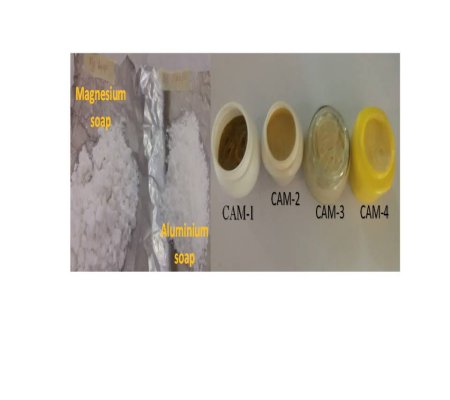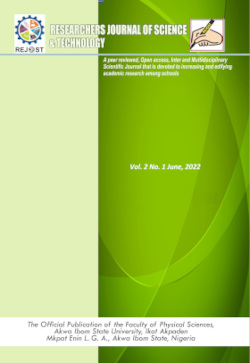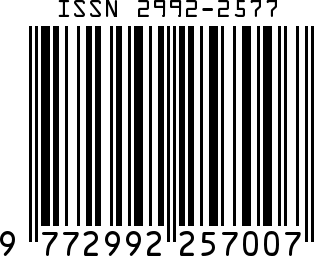Studies on the utilization of Hura crepitans seed oil, aqueous extract of Curcuma longa L., aluminium, and magnesium metallic soaps in the preparation of emollient cream
Keywords:
aluminium soap, magnesium soap, oil-in-water emulsion, physical stability, shea butter, triglyceride oil, turmeric extractAbstract
Skin is one of the sense organs that if properly cared for not only helps in body temperature regulation but as a means for drug delivery. The use of locally sourced natural products for the preparation of value-added products in the area of health care products such as cosmetics is receiving a boost because of its environmentally benign nature. This study is aimed at using locally sourced triglyceride oils, magnesium and aluminium soaps for the preparation of emollient cream. Hura crepitans seed oil (HCSO) was extracted via solvent extraction method and characterized using standard methods. Aluminium and magnesium soaps were prepared from palm kernel oil sodium soap through the precipitation method. The metallic soaps were characterized using standard methods. Four emollient cream samples (CAM-1, CAM-2, CAM-3 and CAM-4) were prepared using an aqueous extract of turmeric, the metallic soaps as thickeners and emulsifiers, shea butter and Hura crepitans seed oil as the oil phase. The product stability was monitored for two years at ambient temperature. The percentage yield and the iodine, acid and saponification values of HCSO were determined as 87.93%, 145.90 gI2/100g, 3.25 mgKOH/g, and 183.34 mgKOH/g respectively. The melting points of aluminium and magnesium soaps were determined as 115 oC and 110 oC respectively. All the cream samples were very stable and exhibited a longer shelf life. Cream sample CAM-3 gave a jelly-like cream texture. HCSO, shea butter and other ingredients if properly harnessed can be a good starting material for the preparation of skincare products.
References
Adazabra, A.N., Viruthagiri, G., Shanmugan, N., 2017. Infrared analysis of clay bricks incorporated with spent shea waste from the shea butter industry. Jour. Environ. Mgt., 191: 66 – 74.
Ajani, O.O., Felicia, T.O., Fisayo, E.O., Deborah K. A., Oluwatosin Y. A., 2019. Phytochemical screening and nutraceutical potential of sandbox tree (Hura crepitans L.) seed oil. Foods Raw Mater., 7(1): 143 – 150.
Akpakpan, A.E., Nsi, E.W., Akpanudo, N.W., Ekwere, I.O., Edem, A. J., 2018. Physicochemical characterization of oil and metallic soaps from two varieties of palm kernel oil (Tenera and Dura). Int. Jour. Modern Chem., 10(1): 33 – 46.
Anandaraji, M., Sudharshan, M.R., 2011. Cardamom, ginger and turmeric. In: Verheye, Willy H. (Ed.), Encyclopedia of Life Support Systems (EOLSS)—Soils, Plant Growth and Crop Production. EOLSS Publishers, Oxford, UK.
Atolani, O., Olabiyi, E.T., Issa, A.A., Azeez, H.T., Onoja, E.G., Ibrahim, S.O., Zubair, M.F., Oguntoye, O.T., Olatunji, G.A., 2016. Green synthesis and characterization of natural antiseptic soaps from the oils of underutilized tropical seed. Sustainable Chem. Pharm., 4: 32 – 39.
Awad El-Gied, A.A., Abdelkareem1, A. M., Hamedelniel, E.I., 2015. Investigation of cream and ointment on antimicrobial activity of Mangifera indica extract. Jour. Adv. Pharm. Tech. Res., 6(2): 53 – 57.
Bocca, B., Pino, A., Alimonti, A., Forte, G. 2014. Toxic metals contained in cosmetics: A status report. Regulatory Toxicol. Pharmacol., 64: 447 – 467.
Ezeh, E., Umoren, E., Essien, E.E., Udoh, A.P., 2012. Studies on the utilization of Hura Crepitans L. seed oil in the preparation of alkyd resins. Ind. Crops Prod., 36: 74-99.
Glew, D., Lovett, 2014. Life cycle analysis of shea butter use in cosmetics: from parklands to product, low carbon opportunities. Jour. Cleaner Production, 68: 73 – 80.
Gonen, M., Balkose, D., Inal, F., Ulka, S., 2005. Zinc stearate production by precipitation and fusion process. Ind. Eng. Chem. Res., 44(6): 1627-1633.
Hall, B., Tozer, S., Safford, B., Caroama, M., Steiling, W., Leneveu-Duchemin, M.C., McNamara, C., Gibney, M., 2007. European consumer exposure to cosmetic products, a framework for conducting population exposure assessments. Food Chem. Toxicol., 45: 2097 – 2108.
Isaac, I.O., Ekpa, O.D., 2009. Minerals and anti-nutrients in two varieties of African pear oil (Dacroydes edulis). Jour. Food Tech., 7(4): 106 – 110.
Isaac, I.O., Ekpa, O.D., Ekpe, U.J., 2014. Extraction, characterization of African pear (Dacryodes edulis). Int. Jour. Adv. Res. Chem. Sci., 1(4): 14 – 22.
Isaac, I.O., Etesin, U.M., Nya, E.J., Ukpong, E.J., Isotuk, U.G., Ibok, U.J., 2022. Ethnobotanical study, phytochemical composition and in vitro antioxidant activity of the methanol extracts of thirty-two medicinal plants from Southern Nigeria. Jour. Medicinal Plants Res., 16(10): 288-299.
Ishikawa, A., Fujii, M., Morimoto, K., Yamada, T., Koizumi, N., Kondoh, M., Watanabe, Y., 2012. Oil-in-water emulsion lotion providing controlled release using 2-methacryloyloxyethyl phosphorylcholine n-butyl methacrylate copolymer as emulsifier. Results in Pharma Sci., 2: 16 – 22.
Karimi, N., Ghanbarzadeha, B., Hamishehkar, H., Mehramuz, B., Kafil, H.S., 2018. Antioxidant, antimicrobial and physicochemical properties of turmeric extract-loaded nanostructured lipid carrier (NLC). Colloid Interface Sci. Comm., 22: 18 – 24.
Lünneman, L., Lurdriksone, L., Schario, S.M., Sawatzky, S., Stroux, A., Blume-Peytavi, U., Garcia, B.N., 2018. Noninvasive monitoring of plant-based formulations on skin barrier properties in infants with dry skin and risk for atopic dermatitis. Int. Jour. Women’s Dermatol., 4: 95 – 101.
Michalun, M.V., Dinardo, J.C., 2015. Milady skin care and cosmetic ingredients dictionary 4th edn. Clifton Park, U.S.A., ISBN: 978-1-285-06079-8. Pp. 45 – 52.
Nielsen, J. B., 2006. Natural oils affect the human skin integrity and the percutaneous penetration of benzoic acid dose-dependently. Basic Clin. Pharmacol. Toxicol., 98: 575 – 581.
Oben, E.K.,Simplice, F.H., Guerisson, B., Folefoc, G.N., Asongalem, E.A., Lagojda, A., Lamshöft, M., 2015. A new ursane triterpenoic acid and other potential anti-inflammatory and anti-arthritic constituents from EtOAc extracts of Vitellaria paradoxa stem bark. Jour. Ethnopharmacol., http://dx.doi.org/10.1016/j.jep.2015.08.014.
Okolie, P. N., Uaboi -Egbenni, P. O., Ajekwene, A. E., 2012. Extraction and quality evaluation of sand box tree seed (Hura crepitans) oil. World Jour. Agric. Sci., 8(4): 359 – 365.
Onwuka, G.I., 2005. Food analysis and instrumentation (theory and practice), 1st edn. Naphthali Prints, Surulere,- Lagos, Nigeria. ISBN: 97804 7686. Pp 140 – 160.
Oyekunle, J.A.O., Omode, A.A., 2008. Chemical composition and fatty acid profile of the lipid fractions of selected Nigerian indigenous oil seeds. Int. Jour. Food Prop., 11: 273 – 281.
Rawlings, A. V., Matts, P.J., 2005. Stratum corneum moisturization at the molecular level: An update in relation to the dry skin cycle. Jour. Invest. Dermatol., 124: 1099 – 1110.
Sathiyabama, M., Bernstein, N., Anusuya, S., 2016. Chitosan elicitation for increased curcumin production and stimulation of defence response in turmeric (Curcuma longa L.). Ind. Crops Prod., 89: 87 – 94.
Simpson, E.L., Charlmers, J.R., Hanifin, J.M., Thomas, K.S., Cork, M.J., McLean, W.H., 2014. Emollient enhancement of the skin barrier from birth offers effective atopic dermatitis prevention. Jour. Allergy Clinical Immunol., 134: 818 – 823.
Singh, P.A., Bajwa, N., Baldi, A., 2021. A comparative review on the standard quality parameters of turmeric. Indian Jour. Nat. Prod., 35(1): 2 – 8.
Umoren, S.A., Ajibersin, K.K., Bala, D.N., 2001. Physicochemical properties of the seed and seed oil of Hura crepitans. Jour. Natural Appl. Sci., 1(2): 23 – 26.
Vassallo, A., Armentano, M.F., Miglionico, R., Caddeo, C., Chirollo, C., Gualtieri, M.J., Ostuni, A., Bisaccia, F., Faraone, I., Milella, L., 2020. Hura crepitans L. extract: phytochemical characterization, antioxidant activity, and nanoformulation. Pharma-ceutics, 12(6): 1 – 14.
Venter, T., Fox, L.T., Gerber, M., du Preez, J.L., van Zyl, S., Boneschans, B., du Plessis, J., 2016. Physical stability and clinical efficacy Crocodylus niloticus oil lotion. Brazilian Jour. Pharmacognosy, 26: 521 – 529.
Zhang, J., Kurita, M., Shinozaki, T., Ukiya, M., Yasukawa, K., Shimizu, N., Tokuda, H., Masters, E.T., Akihisa, M., Akihisa, T., 2014. Triterpene glycosides and other polar constituents of shea (Vitellaria paradoxa) kernels and their bioactivities. Phytochem., 108: 157 – 170.

Downloads
Published
How to Cite
Issue
Section
License

This work is licensed under a Creative Commons Attribution-NonCommercial-NoDerivatives 4.0 International License.




